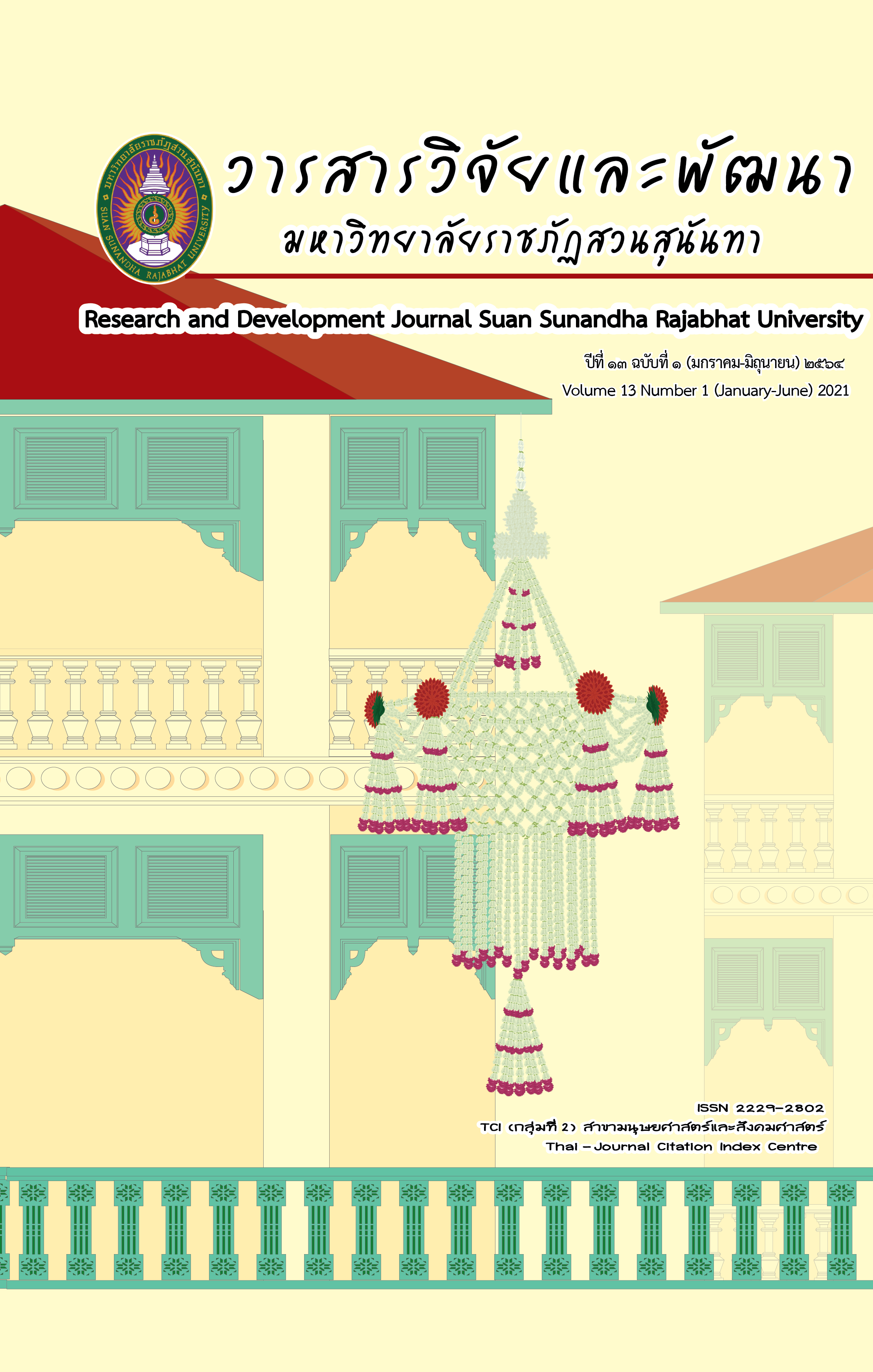ความสัมพันธ์ระหว่าง โภชนบัญญัติ 9 ประการ กับการตัดสินใจสั่งอาหารผ่านแอปพลิเคชันออนไลน์ ของนักเรียนมัธยมศึกษาตอนปลาย เขตพื้นที่การศึกษามัธยมศึกษาเขต 1 ภายใต้ฐานวิถีชีวิตใหม่
DOI:
https://doi.org/10.53848/irdssru.v13i1.250238คำสำคัญ:
โภชนบัญญัติ 9 ประการ, กระบวนการตัดสินใจสั่งอาหาร, แอปพลิเคชันออนไลน์, ฐานวิถีชีวิตใหม่, กทม.บทคัดย่อ
การวิจัยนี้ศึกษาระดับความสำคัญของโภชนบัญญัติ 9 ประการ ที่ส่งผลต่อการสั่งอาหารผ่านแอปพลิเคชันออนไลน์ และวิเคราะห์ความสัมพันธ์ระหว่างโภชนบัญญัติ 9 ประการ กับกระบวนการตัดสินใจสั่งอาหารผ่านแอปพลิเคชันออนไลน์ ของนักเรียนมัธยมศึกษาตอนปลาย เขตพื้นที่การศึกษามัธยมศึกษาเขต 1 ภายใต้ฐานวิถีชีวิตใหม่ เป็นการวิจัยเชิงปริมาณ กลุ่มตัวอย่างเป็นนักเรียนชั้นมัธยมศึกษาตอนปลาย โรงเรียนมัธยมศึกษาขนาดใหญ่พิเศษ สังกัดสำนักงานเขตพื้นที่การศึกษามัธยมศึกษาเขต 1 กรุงเทพมหานคร ที่เคยใช้บริการซื้ออาหารผ่านแอปพลิเคชันออนไลน์ อย่างน้อย 1 ครั้ง จำนวน 400 คน โดยมีแบบสอบถามเป็นเครื่องมือในการเก็บรวบรวมข้อมูล โดยวิธีสุ่มตัวอย่างแบบแบ่งชั้นภูมิ สถิติที่ใช้ในการวิเคราะห์ข้อมูล ได้แก่ ค่าเฉลี่ย ค่าส่วนเบี่ยงเบนมาตรฐาน และค่าสัมประสิทธิ์สหสัมพันธ์แบบเพียร์สัน ผลการวิเคราะห์ระดับความสำคัญของโภชนบัญญัติ 9 ประการ ที่ส่งผลต่อการสั่งอาหารผ่านแอปพลิเคชันออนไลน์ ภายใต้ฐานวิถีชีวิตใหม่ โดยภาพรวม พบว่า มีความสำคัญในระดับปานกลาง เมื่อพิจารณาเป็นรายข้อ พบว่า อยู่ในระดับมาก 7 ข้อ อยู่ในระดับน้อย 1 ข้อ และอยู่ในระดับน้อยที่สุด 1 ข้อ สำหรับผลการวิเคราะห์ความสัมพันธ์ระหว่างโภชนบัญญัติ 9 ประการ กับกระบวนการตัดสินใจสั่งอาหารผ่านแอปพลิเคชันออนไลน์ ของนักเรียนมัธยมศึกษาตอนปลายเขตพื้นที่การศึกษามัธยมศึกษาเขต 1 ภายใต้ฐานวิถีชีวิตใหม่ พบว่า โดยภาพรวม มีความสัมพันธ์ในระดับต่ำ ในทิศทางตรงกันข้าม เมื่อพิจารณาเป็นรายด้าน พบว่า มีความสัมพันธ์ในระดับต่ำ เป็นไปในทิศทางเดียวกัน จำนวน 4 ข้อ ดังนี้ ด้านกินอาหารที่สะอาดปราศจากการปนเปื้อน รองลงมาคือ ด้านกินพืชผักให้มาก และกินผลไม้เป็นประจำ ด้านกินปลา เนื้อสัตว์ไม่ติดมัน ไข่ และถั่วเมล็ดแห้ง และด้านกินอาหารที่มีไขมันแต่พอควร และมีความสัมพันธ์ในระดับต่ำ เป็นไปในทิศทางตรงกันข้าม จำนวน 5 ข้อ ดังนี้ 1.ด้านหลีกเลี่ยงการกินอาหารรสหวานจัด และเค็มจัด 2.ด้านกินอาหารครบ 5 หมู่ แต่ละหมู่ให้หลากหลาย และหมั่นดูแลน้ำหนักตัว 3.ด้านดื่มนมให้เหมาะสมตามวัย 4.ด้านงดหรือลดเครื่องดื่มที่มีแอลกอฮอล์ 5. ด้านกินข้าวเป็นอาหารหลักสลับกับอาหารประเภทแป้งเป็นบางมื้อ ตามลำดับ
เอกสารอ้างอิง
Centre for the Administration of the Situation due to the Outbreak of the Communicable Disease Coronavirus 2019. (2021). Situation of Coronavirus 2019 (COVID-19) in Thailand. Retrieved January 25, 2021, from http://www.moicovid.com/.
Department of Disease Control. (2020). Names and major symptoms of dangerous communicable diseases 2020. Retrieved April 15, 2020, from https://ddc.moph.go.th/viralpneumonia/
Manolee Sripaoraya Penpong. (2016). Food consump tion behavior of students in Suratthani Province. Journal of Management Sciences, 3(1), 109-126.
Ministry of Education. (2020). Educational institutions under and under supervision of the ministry of education closed classes due to special reasons. Retrieved April 15, 2020, from https://www.moe.go.th/.
Ministry of Higher Education, Science, Research and Innovation. (2021). Number of people infected (COVID-19) worldwide. Retrieved January 25, 2021, from https://www.mhesi.go.th/.
Ministry of Higher Education, Science, Research and Innovation. (2020). New Normal. Retrieved June 14, 2020, from https://www.mhesi.go.th/.
National Statistical Office of Thailand. (2018). Statistics of the using the ICT of children and youth in 2018. Retrieved September 1, 2018, from http://www.nso.go.th/sites/2014/Pages/News/2561/N25-07-61-2.aspx
Nattanicha Wannamanee and and Nunnaphat Petsuwan. (2019). Factors related to health behaviors and nutritional status of elementary students in Mueang District, Songkhla Province. In 10th Hatyai National and International Conference (pp. 764-778). Hatyai: Hatyai University.
Paveenapat Nithitantiwa and Warangkana Udomsapay.(2017). Food consumption behavior among Thai adolescents, impacts, and solutions. Journal of Phrapokklao Nursing College, 28(1), 122-128.
Sirote Pholpuntin and chanasuek Nichanon. (2020). Food consumption in the era of "New Normal". Retrieved January 5, 2020, from https://web.facebook.com/suandusitdelivery/photos/pcb.128115908876321/128115485543030/.
Suchada Chuersa-Ard. (2013). Nutritional Status knowledge and practice on food-based dietary guidelines for Thais of high school students, Regina Coeli college (Master’s thesis). Chiang Mai University. Chiang Mai.
Suchart Somprayoon. (1998). Teaching health education. (3rd ed.). Bangkok: Thai Watana Panich.
Sunundha Youngwanichsetha and Sasitorn Phumdoung. (2018). Effects health of drinking nectar, iced tea, iced coffee, and the other beverages mixing the sugar and fructose. Retrieved June 9, 2020, from https://rdo.psu.ac.th/index.php/recommend/1099-2018-08-02-07-52-23.
Tanin Silpjaru. (2017). Statistical research
and analysis with SPSS and and AMOS. ( 17 th edition ). Nonthaburi:S.R. Printing Mass Products Co., Ltd.
The Royal College of Pediatricians of Thailand. (2017). Parent guide for publishing the knowledge about care and development children. Retrieved April 15, 2021, from http://www.thaipediatrics.org/Media/media20171010123138.pdf.
The Secondary Educational Service Area Office 1. (2020). Information on the number of high school students semester 1, academic year 2020. Retrieved June 10, 2020, from https://Eservice.sesao1.go.th/info/maps/student.
ดาวน์โหลด
เผยแพร่แล้ว
รูปแบบการอ้างอิง
ฉบับ
ประเภทบทความ
สัญญาอนุญาต
บทความที่ได้รับการตีพิมพ์เป็นลิขสิทธิ์ของ สถาบันวิจัยและพัฒนา มหาวิทยาลัยราชภัฎสวนสุนันทา
ข้อความที่ปรากฏในบทความแต่ละเรื่องในวารสารวิชาการเล่มนี้เป็นความคิดเห็นส่วนตัวของผู้เขียนแต่ละท่านไม่เกี่ยวข้องกับมหาวิทยาลัยราชภัฎสวนสุนันทา และคณาจารย์ท่านอื่นๆในมหาวิทยาลัยฯ แต่อย่างใด ความรับผิดชอบองค์ประกอบทั้งหมดของบทความแต่ละเรื่องเป็นของผู้เขียนแต่ละท่าน หากมีความผิดพลาดใดๆ ผู้เขียนแต่ละท่านจะรับผิดชอบบทความของตนเองแต่ผู้เดียว





